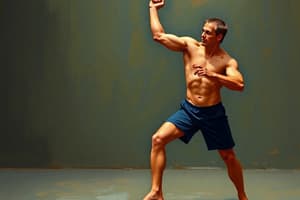Podcast
Questions and Answers
What is the primary purpose of flexibility exercises?
What is the primary purpose of flexibility exercises?
- Enhance range of motion (correct)
- Increase muscle strength
- Develop endurance
- Improve tactical skills
Which of the following best describes dynamic stretching?
Which of the following best describes dynamic stretching?
- Movement-based stretching techniques (correct)
- Stretching without any movement
- Holding a stretch for an extended period
- Stretching major muscle groups post-workout
What kind of training involves alternating high-intensity efforts with periods of rest?
What kind of training involves alternating high-intensity efforts with periods of rest?
- Continuous Training
- Anaerobic Training
- Interval Training (correct)
- Aerobic Training
Which benefit is associated with strength training?
Which benefit is associated with strength training?
What type of skills involves understanding strategies and decision-making in sports?
What type of skills involves understanding strategies and decision-making in sports?
What is the principle of gradual increases in resistance to stimulate muscle growth in strength training called?
What is the principle of gradual increases in resistance to stimulate muscle growth in strength training called?
What is the main focus of sport-specific skills training?
What is the main focus of sport-specific skills training?
Which type of flexibility technique is commonly used after workouts?
Which type of flexibility technique is commonly used after workouts?
Flashcards are hidden until you start studying
Study Notes
Flexibility Exercises
- Purpose: Enhance range of motion, reduce injury risk, improve athletic performance.
- Types of Flexibility:
- Static: Holding a stretch for a period.
- Dynamic: Stretching through movement.
- Common Techniques:
- Static Stretching: Target muscle groups after workouts (e.g., hamstrings, quadriceps).
- Dynamic Stretching: Incorporate movements like leg swings and arm circles during warm-ups.
- Benefits:
- Improved muscle coordination.
- Better posture and alignment.
- Reduced soreness after workouts.
Endurance Training
- Purpose: Improve cardiovascular fitness, stamina, and overall endurance.
- Types:
- Aerobic Training: Activities such as running, cycling, swimming; sustained for extended periods.
- Anaerobic Training: High-intensity bursts with short recovery (e.g., sprinting).
- Methods:
- Continuous Training: Steady intensity over a long duration.
- Interval Training: Alternating high-intensity efforts with rest or lower intensity.
- Benefits:
- Enhanced heart and lung capacity.
- Improved muscle efficiency.
- Better fat metabolism.
Strength Training
- Purpose: Increase muscle strength, power, and hypertrophy.
- Types:
- Bodyweight Exercises: Utilizes own body weight (e.g., push-ups, squats).
- Resistance Training: Involves weights or resistance bands (e.g., deadlifts, bench presses).
- Principles:
- Progressive Overload: Gradually increasing resistance to stimulate muscle growth.
- Specificity: Tailoring workouts to target specific muscle groups for sport performance.
- Benefits:
- Improved muscle mass and bone density.
- Enhanced athletic performance and injury prevention.
- Increased metabolic rate.
Sport-specific Skills
- Purpose: Develop skills tailored to specific sports for improved performance.
- Types of Skills:
- Technical Skills: Execution of sport-specific movements (e.g., passing in soccer, shooting in basketball).
- Tactical Skills: Understanding strategies and decision-making (e.g., positioning, game awareness).
- Training Techniques:
- Drills: Repetitive practice of specific skills.
- Simulation: Practicing skills in game-like scenarios.
- Benefits:
- Enhanced performance in competitive settings.
- Greater confidence and skill execution under pressure.
- Improved ability to read and react to game situations.
Flexibility Exercises
- Enhances range of motion, reduces injury risk, and improves athletic performance.
- Types of Flexibility:
- Static involves holding a stretch, aiding post-workout recovery.
- Dynamic involves stretching through movement, promoting readiness for activity.
- Common Techniques:
- Static stretches target specific muscle groups after workouts (e.g., hamstrings, quadriceps).
- Dynamic stretches include movements like leg swings and arm circles during warm-ups.
- Benefits:
- Improves muscle coordination, contributing to better overall athletic performance.
- Promotes better posture and alignment, reducing chronic pain.
- Reduces soreness after workouts, aiding recovery.
Endurance Training
- Aims to improve cardiovascular fitness, stamina, and overall endurance.
- Types:
- Aerobic training includes sustained activities such as running, cycling, and swimming.
- Anaerobic training consists of high-intensity bursts with short recovery periods, like sprinting.
- Methods:
- Continuous training involves steady intensity over prolonged durations, beneficial for aerobic capacity.
- Interval training alternates between high-intensity efforts and rest or lower intensity, optimizing fitness gains.
- Benefits:
- Enhances heart and lung capacity, supporting overall health and performance.
- Improves muscle efficiency, allowing for better energy use during activity.
- Aids in better fat metabolism, contributing to weight management.
Strength Training
- Focuses on increasing muscle strength, power, and hypertrophy.
- Types:
- Bodyweight exercises utilize one's own mass (e.g., push-ups, squats).
- Resistance training incorporates external weights or bands to increase load (e.g., deadlifts, bench presses).
- Principles:
- Progressive overload requires gradual increases in resistance to stimulate muscle growth effectively.
- Specificity tailors workouts to target specific muscle groups for improved sport performance.
- Benefits:
- Increases muscle mass and bone density, contributing to better health.
- Enhances athletic performance and injury prevention through stronger musculature.
- Boosts metabolic rate, aiding in calorie burn.
Sport-specific Skills
- Develops skills tailored to specific sports for enhanced performance.
- Types of Skills:
- Technical skills involve execution of important movements (e.g., passing in soccer, shooting in basketball).
- Tactical skills focus on strategies and decision-making relevant to the sport (e.g., positioning and game awareness).
- Training Techniques:
- Drills involve the repetitive practice of specific skills to build muscle memory.
- Simulation offers practice in game-like scenarios, enhancing adaptability under pressure.
- Benefits:
- Enhances performance in competitive settings, allowing athletes to perform at their best.
- Increases confidence and skill execution, particularly in high-pressure situations.
- Improves ability to read and react to game situations, fostering better in-game decisions.
Studying That Suits You
Use AI to generate personalized quizzes and flashcards to suit your learning preferences.




